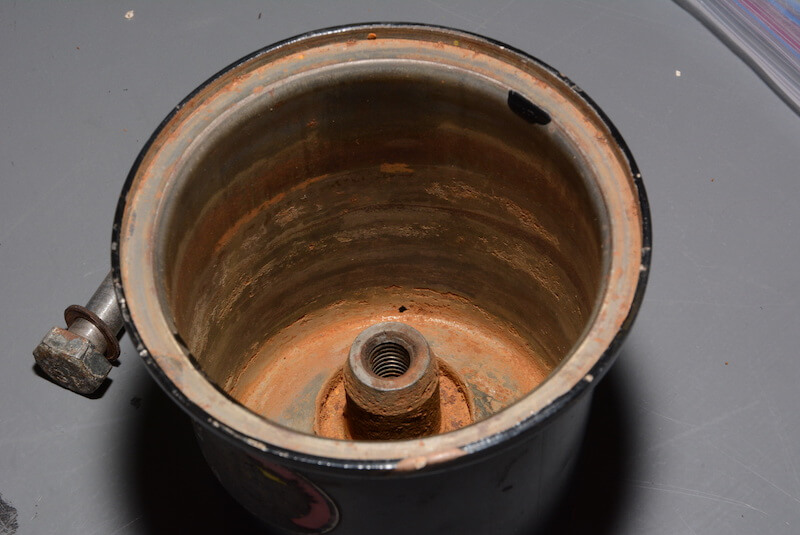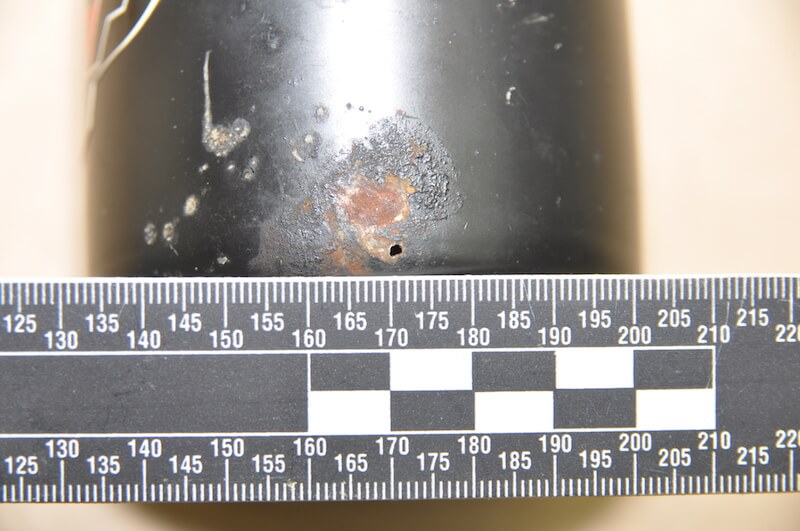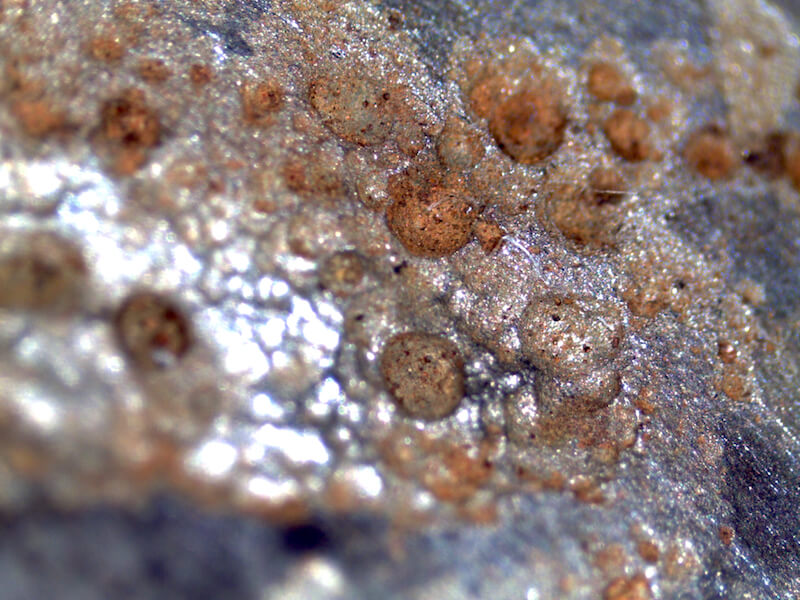
An estimated 1.2 million households in Canada are heated by fuel oil. These households are predominantly located in rural areas. Though a functional and efficient heat source, these systems pose various risks to the homeowner. Their failures can result in the escape of hundreds of liters of oil into the surrounding environment – below foundations, and into wells, sumps, weeping tile, and groundwater. The associated remediation work is costly and can easily exceed the property value.
Numerous types of oil heating system component failures have been studied and documented. For example, internal corrosion of single-walled heating oil tanks has long been recognized as an insidious mode of failure that can cause an oil tank to leak with little or no warning.
However, one of the lesser-known and preventable sources of oil escapes are corrosion failures of inline oil filters. These filters are widely used in heating oil systems, and their basic design has not been altered in the past 50 years. While there has been a widespread focus in recent years on the updating of tank designs, inline oil filters represent an overlooked, but significant item for attention from homeowners, maintenance companies, insurers, and lawyers.
OIL SYSTEM COMPONENTS
Typical residential heating oil aboveground storage tanks (ASTs) have an approximate capacity ranging from 680 to 1135 liters. These tanks can be installed inside or outside of a building. Piping connected to a shutoff valve at the tank outlet, routes the fuel oil through a filter and to the furnace burner.
WHY DO OIL SYSTEMS FAIL?
Oil heating systems leak for a multitude of reasons. Nearly half of failures occur due to corrosion of components2 . The second most common cause for loss of oil containment is due to piping separations at elbows and other connections. Less common causes include the overfilling of tanks, vandalism, and accidental mechanical damage to systems.
The most obvious corrosion damage occurs on the exterior surfaces of components such as tanks, filters and piping. However, Microbially Influenced Corrosion (MIC) can initiate on the interior surfaces of these components, causing failures to occur over short time periods with little to no warning. This type of corrosion damage is more insidious since detailed internal inspection of components is required to determine their condition.
The presence and intensity of MIC is dependent on the presence of water, and results from the evolution of various types of bacteria and fungi. These bacteria and fungi can enter the system through oil refining, storage or the surrounding environment at installation. Water can also enter the heating oil system as a component of heating oil (0.02 % by volume (%/v)), as well as through condensation, tank vents, and human error. The rate of material loss due to this type of corrosion has been measured at up to 0.7 mm/year (0.028 in/ year 3 ) , which is sufficient to quickly cause failures of oil heating system components.
WHY DO OIL FILTERS FAIL?
An oil filter is a required component of an oil heating system by the Installation Code for Oil-Burning Equipment (CSA-B139) and the Ontario Installation Code for Oil Burning Equipment. In addition, the absence of an oil filter in a system will typically void the warranty of system components. These filters prevent the passage of water, sediments and debris from the tank to the burner. However, as a consequence, these substances will collect and stagnate within the filter canister and cartridge, forming a favorable environment for MIC.
As previously mentioned, the basic heating oil filter design has remained relatively unchanged for the past 50 years. Their typical design consists of a disposable filter cartridge contained within a reusable filter canister (or “bowl”) and filter head. In this design, the filter canister is typically constructed from sheet steel ranging from 0.5 to 1.5 mm in thickness. In recent years, a new filter design has emerged – the “spin-on” filter. In this updated design, both the cartridge and canister are disposable.
In the “old-style” filter design, when the filter cartridge is replaced, the interior surfaces of the canister and head must be inspected in order to determine whether corrosion is present prior to their reuse. The “spinon” design largely eliminates this step by making the cartridge and canister disposable. Due to the clear risk of internal corrosion, most manufacturers (of both designs) now also apply an internal protective coating to filter canisters.

WHY IS THIS AN ISSUE NOW?
In contrast to oil filters, oil tank failures due to MIC have been widely documented, researched, and litigated. The “classic’’ failing oil tanks were (and are) single-walled, constructed from carbon steel (2.0 to 2.3 mm in thickness), without an internal protective coating. The design of such tanks constituted an ideal environment for the proliferation of bacteria and fungi and the propagation of MIC. As a result, oil tank manufacturers updated their designs, releasing tanks with multiple walls (or layers), leak detection systems and constructed from materials less prone to corrosion such as composites. These designs served to increase consumer, insurer, and government confidence in oil heating systems, and to mitigate the risks that became all too obvious in older systems.
However, while the replacement of “classic” style tanks with an “updated” design may seem like a total solution, it is actually only addressing the most visible issue. Further consideration shows that by reducing the susceptibility of a single component to MIC failure without the elimination of the conducive environment, failures will continue to occur in other vulnerable system components, such as oil filters.

WHAT CAN BE DONE?
The good news is that problems with filters can be greatly minimized through one single measure: inspection. While the inspection of oil tanks is difficult and largely ineffective, filters are simple to inspect and inexpensive to replace.
The Installation Code for Oil-Burning Equipment (CSA B139), the Ontario Installation Code for Oil Burning Equipment as well as manufacturers’ instructions mandate owners to perform yearly oil filter inspections and/or replacement. Many equipment owners retain maintenance companies to perform these inspections, which generally involve the replacement of the filter cartridge. Depending on the type of filter installed, this may involve the simple disposal and exchange of the “spin-on” assembly, or an inspection and assessment of the interior condition of the canister for continued service, and (if deemed satisfactory) replacement of the filter cartridge.
During the inspection of oil filters with an “old-style” design, careful internal inspection is necessary to determine whether corrosion damage is present. Where damage is present, the canister cannot be reused and must be replaced. In cases where an adequate internal filter inspection does not take place, the risk of future corrosion failure will be greatly increased. In those cases, the equipment owner or maintenance provider can be held liable for a spill. In certain circumstances, component manufacturers can also be held liable.
In these types of investigations, it is prudent to retain an experienced forensic engineering company to determine the cause of failure and potential liability for the loss. CEP Forensic is equipped to perform complete investigations of heating oil filter failures including site examinations, code reviews, and failure analyses.
If you have any questions or would like to learn more about this topic, please contact our Materials Engineering Team at 877 686-0240 or info@cep-experts.ca
